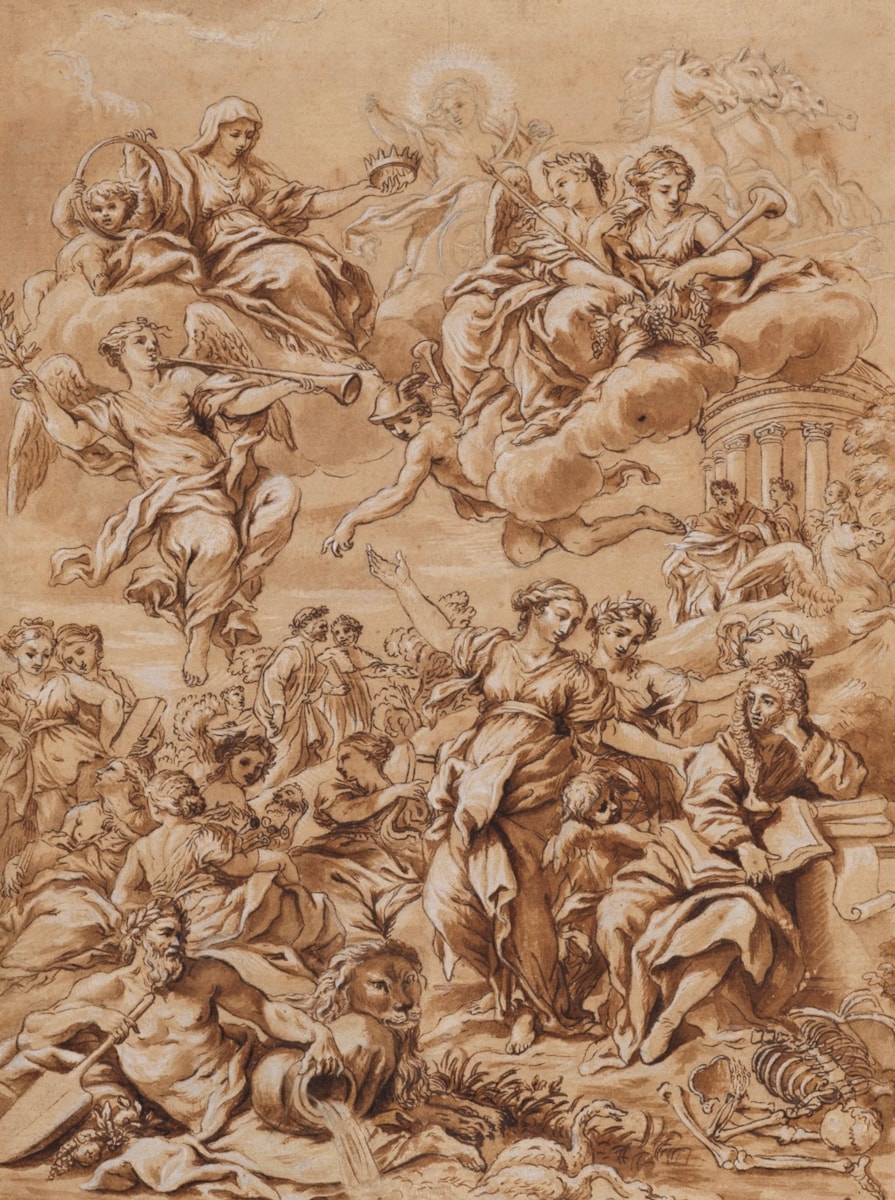
Anton Domenico Gabbiani (Florence 1652 - Florence 1726)
Francesco Redi crowned by the muses
Description:
collector’s drystamp lower centre [L. 420]
pen and brown ink with brown wash, over traces of black chalk, heightened with white
332 x 243 mm
Provenance:
Ignazio Hugford (1703 – 1778), Florence
Benjamin Wolff (1790 – 1866), Engelholm near Copenhagen [L.420]
Thence by descent, until
His sale, Bruun Rasmussen, Copenhagen: 1 June 2018, Lot 8626
Private collection, Florence
Literature
I. Hugford, Vita di Anton Domenico Gabbiani pittor fiorentino, Florence, 1762, pp. 12-13
Serie degli uomini i più illustri nella pittura, scultura, e architettura, XII, Florence, 1775, p. 52
U. Viviani, Vita, Opere, Iconografia e Bibliografia di F. Redi, Vita, Opere, Iconografia, Bibliografia, Vocabolario inedito delle Voci Aretine e Libro inedito dei “Ricordi” di Francesco Redi Aretino, I, Arezzo, Viviani, 1924, p. 89
F. Borroni Salvadori, ‘Le esposizioni d’arte a Firenze dal 1674 al 1767’, in Mitteilungen des Kunsthistorischen Institutes in Florenz, 18, 1974, p. 88
J. T. Spike, Baroque Portraiture in Italy: Works from North American Collections, Sarasota, 1984, p. 90
S. Casciu, ‘Aggiornamenti e nuove acquisizioni per l’iconografia rediana’, in W. Bernardi and L. Guerrini (eds.), Francesco Redi. Un protagonista della scienza moderna. Documenti, esperimenti, immagini, Florence, 1999, p. 269
Exhibitions
Florence, Cloister of SS. Annunziata, July 1767, cat no. 46 (lent by Hugford)
Note:
Engraved:
Fra Antonio Lorenzini in F. Redi, Sonetti del Signor Francesco Redi Aretino, Accademico della Crusca, 1702, Florence
Long thought to be lost, this drawing by Anton Domenico Gabbiani was only known to scholars through an engraving in the reverse sense by Antonio Lorenzini (1655–1740). Lorenzini’s engraving was used as the frontispiece for the decorated 1702 edition of Sonetti del Signor Francesco Redi Aretino, a collection of sonnets written by the late scholar and polymath, Francesco Redi (1626-1697). Redi was a venerated scientist, physician and an Academician of Cimento who held the favour of Grand Prince Ferdinando de’ Medici, the son of the Grand Duke Cosimo III. On Redi’s death the Grand Prince commissioned the publication of 60 of Redi’s sonnets to honour his chief physician and assigned the decoration of the collection’s frontispiece to Gabbiani, his official painter.
The complex iconography of Gabbiani’s composition is described in full by Ignazio Hugford (1703-1778), a student and biographer of Gabbiani, in his 1762 Vita di Anton Domenico Gabbiani pittor fiorentino. On Gabbiani’s death in 1726, Hugford inherited much of his master’s collection and amongst the large collection of paintings and drawings - including many sheets originating directly from the Medici family - was the present drawing.
The dense composition reflects Gabbiani’s industrious activity as a fresco painter – Hugford reports that he painted some 36 frescoes in his lifetime – with the figures arranged schematically on Mount Parnassus. Redi is seated prominently to the right of the composition, leaning on his books. One muse crowns Redi with a laurel wreath whilst a second beckons up toward the crown of Eternal fame. Detached from what is happening around him, Redi seems caught in poetic reverie, as if the poet, in this moment of earthly glory, reflects on the transience of life which is represented by the memento mori sprawled at his feet. In the foreground to the left, a personification of the river Arno reclines beside the heraldic lion of Florence, the Marzocco. Behind these figures the Muses are grouped in conversation at the foot of the slope which leads toward the Temple of Virtue and the winged-horse Pegasus. Petrach and Dante are seen climbing the slope, with Torquato Tasso behind them. Five ancient Greek poets are grouped beside the temple. Below the clouds fly Mercury and Fame to the centre and left. Above them rests Eternity seated on a cloud, holding the crown of lasting fame reserved for Redi. Virtue and Poetry sit on the cloud to the right. Above all is Apollo, leader of the muses, mounted on a horse-drawn chariot and carrying a lyre.
Please contact us for a full catalogue entry.
